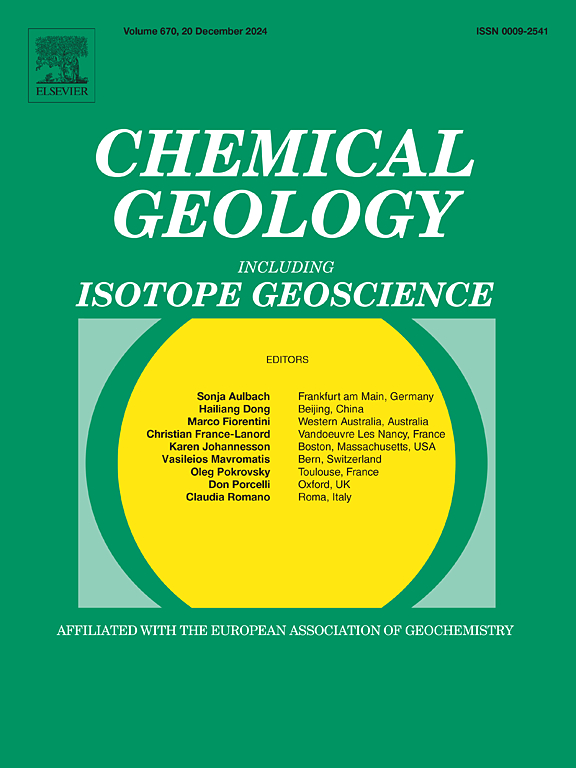奥陶系-志留系冰后过渡期边缘海洋盐度硼同位素证据及其对氧化还原条件和生物恢复的影响
IF 3.6
2区 地球科学
Q1 GEOCHEMISTRY & GEOPHYSICS
引用次数: 0
摘要
边缘海洋环境的缺氧条件在古海洋学和古生态学研究中起着至关重要的作用。了解缺氧的机制需要深入了解研究区域的水团条件。虽然盐度是水的基本属性,但重建古盐度及其对古代系统氧化还原条件的影响的代用指标经常被忽视。为了说明这一点,我们重点研究了奥陶—志留纪过渡时期(OST)的扬子边缘海,特别是早志留纪冰川后缺氧。利用约447.62 ~ 43849万年前中国南方扬子地块富有机质燧石岩和黑色页岩的盐度和氧化还原条件代用记录进行了研究。我们的研究首次报道了OST期间体硼(B)同位素(δ11B)值的变化。分析古盐度数据(δ11B和B/镓(Ga))以及氧化还原指标(钼(Mo)、铀(U)和钒(V)),为长江边缘海中部连续垂直水文变化提供了约束条件。分析表明,由于与海洋的良好联系,研究区水团在晚奥陶世与海水的盐度接近。随后在志留纪早期,由于冰川融水的涌入,盐度下降。冰川后变暖引起的淡水输入和海平面变化随后导致了强烈的海水分层和初级生产力的提高。这种浅水和深水交换的中断导致了早志留世长江缺氧的发展,这一现象对地球的进化史产生了重大影响。我们的研究为晚奥陶世大灭绝事件和随后的生物恢复提供了新的见解。此外,我们强调了将氧化还原分析与盐度重建结合起来解释缺氧环境机制的重要性。本文章由计算机程序翻译,如有差异,请以英文原文为准。
Boron isotope evidence for Ordovician-Silurian Transition postglacial marginal marine salinity with implications for redox conditions and biotic recovery
Anoxic conditions in marginal marine settings play a critical role in paleoceanographic and paleoecological studies. Understanding the mechanisms underpinning anoxia requires insights into watermass conditions in the study area. While salinity is a fundamental property of water, proxies for reconstructing paleosalinity and its influence on redox conditions in ancient systems are often overlooked. To illustrate this, we focus on the Yangtze Marginal Sea during the Ordovician-Silurian Transition (OST), specifically the Early Silurian postglacial anoxia. We utilized proxy records for salinity and redox conditions archived in organic-rich cherts and black shales deposited in the Yangtze Block, South China, between ca. 447.62–438.49 million years ago. Our study is the first to report the variation in bulk boron (B) isotopic (δ11B) values during the OST. Analyzing paleosalinity data, such as δ11B and B/gallium (Ga) along with redox indicators, such as molybdenum (Mo), uranium (U), and vanadium (V), provides constraints on the continuous vertical hydrological variability across the central Yangtze Marginal Sea. Our analysis suggests that the watermass in the study area was close in salinity to seawater during the Late Ordovician due to a well-established connection with the ocean. This was followed by a decline in salinity in the Early Silurian resulting from an influx of glacial melt water. Postglacial warming-induced freshwater input and sea-level change subsequently contributed to strong seawater stratification and elevated primary productivity. This disruption in the exchange between shallow and deep waters led to the development of anoxia in the Early Silurian Yangtze Sea, a phenomenon that has significantly impacted Earth's evolutionary history. Our study provides fresh insights into the Late Ordovician Mass Extinction event and the subsequent biotic recovery. In addition, we underscore the importance of integrating redox analyses with salinity reconstructions in explaining the mechanisms of anoxic environments.
求助全文
通过发布文献求助,成功后即可免费获取论文全文。
去求助
来源期刊

Chemical Geology
地学-地球化学与地球物理
CiteScore
7.20
自引率
10.30%
发文量
374
审稿时长
3.6 months
期刊介绍:
Chemical Geology is an international journal that publishes original research papers on isotopic and elemental geochemistry, geochronology and cosmochemistry.
The Journal focuses on chemical processes in igneous, metamorphic, and sedimentary petrology, low- and high-temperature aqueous solutions, biogeochemistry, the environment and cosmochemistry.
Papers that are field, experimentally, or computationally based are appropriate if they are of broad international interest. The Journal generally does not publish papers that are primarily of regional or local interest, or which are primarily focused on remediation and applied geochemistry.
The Journal also welcomes innovative papers dealing with significant analytical advances that are of wide interest in the community and extend significantly beyond the scope of what would be included in the methods section of a standard research paper.
 求助内容:
求助内容: 应助结果提醒方式:
应助结果提醒方式:


